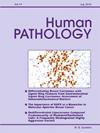Best pathology practices for HER2 testing interpretation, including HER2-low and ultralow, in the era of HER2-directed antibody drug conjugates (ADCs), aligned with the 2018 CAP/ASCO HER2 guidelines
IF 2.6
2区 医学
Q2 PATHOLOGY
引用次数: 0
Abstract
With the emergence of studies showing clinical response to novel human epidermal growth factor receptor 2(HER2)-targeted treatments among HER2-low and HER2-ultralow metastatic breast cancer patients, this gives hope to patients failing to respond to conventional treatment. Hence, the interest in identifying these group of patients is becoming important. Pathologists' interpretation and scoring of HER2 immunohistochemistry (IHC) was challenged from a dichotomous way to a ternary way of reporting. But HER2 IHC testing is affected by a number of pre-analytic, analytic and post-analytic challenges that could affect interpretation at the lower HER2 protein expression range. Interobserver variability among pathologists and inter-assay variabilities likewise posses a challenge since prior guidelines’ emphasis were focused on recognizing HER2-overexpressed from HER2-non-overexpressed tumours. In consideration of these clinical trials, the American Society of Clinical Oncologists and College of American Pathologists (ASCO/CAP) updated and reaffirmed the guideline on HER2 testing in 2018 and in 2023, with the criteria for HER2 categories redefined. Here, we reviewed the definition and differences among HER2-low, HER2-ultralow and HER2-null breast cancer cases as well as the different challenges on HER2 IHC testing encountered and reported, including best pathology practice recommendations to avaoid or minimize these challenges.
HER2定向抗体药物偶联物(adc)时代HER2检测解释的最佳病理实践,包括HER2低和超低,符合2018年CAP/ASCO HER2指南。
随着研究的出现,新型人表皮生长因子受体2(HER2)靶向治疗在HER2低和HER2超低转移性乳腺癌患者中的临床反应,这给传统治疗无效的患者带来了希望。因此,识别这些患者群体的兴趣变得越来越重要。病理学家对HER2免疫组织化学(IHC)的解释和评分受到了从二分法到三元法的挑战。但是HER2 IHC检测受到许多分析前、分析和分析后挑战的影响,这些挑战可能影响HER2蛋白较低表达范围的解释。病理学家之间的观察者之间的可变性和检测之间的可变性同样具有挑战性,因为先前的指南强调的重点是识别her2过表达和her2非过表达的肿瘤。考虑到这些临床试验,美国临床肿瘤学会和美国病理学家学会(ASCO/CAP)在2018年和2023年更新并重申了HER2检测指南,并重新定义了HER2类别的标准。在这里,我们回顾了HER2低、HER2超低和HER2无乳腺癌病例的定义和差异,以及HER2 IHC检测遇到和报道的不同挑战,包括避免或尽量减少这些挑战的最佳病理实践建议。
本文章由计算机程序翻译,如有差异,请以英文原文为准。
求助全文
约1分钟内获得全文
求助全文
来源期刊

Human pathology
医学-病理学
CiteScore
5.30
自引率
6.10%
发文量
206
审稿时长
21 days
期刊介绍:
Human Pathology is designed to bring information of clinicopathologic significance to human disease to the laboratory and clinical physician. It presents information drawn from morphologic and clinical laboratory studies with direct relevance to the understanding of human diseases. Papers published concern morphologic and clinicopathologic observations, reviews of diseases, analyses of problems in pathology, significant collections of case material and advances in concepts or techniques of value in the analysis and diagnosis of disease. Theoretical and experimental pathology and molecular biology pertinent to human disease are included. This critical journal is well illustrated with exceptional reproductions of photomicrographs and microscopic anatomy.
 求助内容:
求助内容: 应助结果提醒方式:
应助结果提醒方式:


